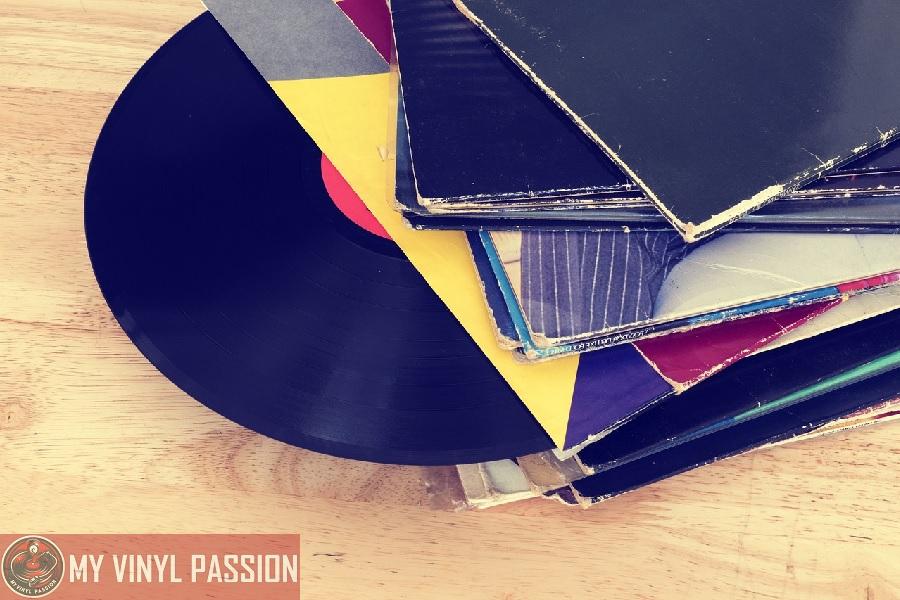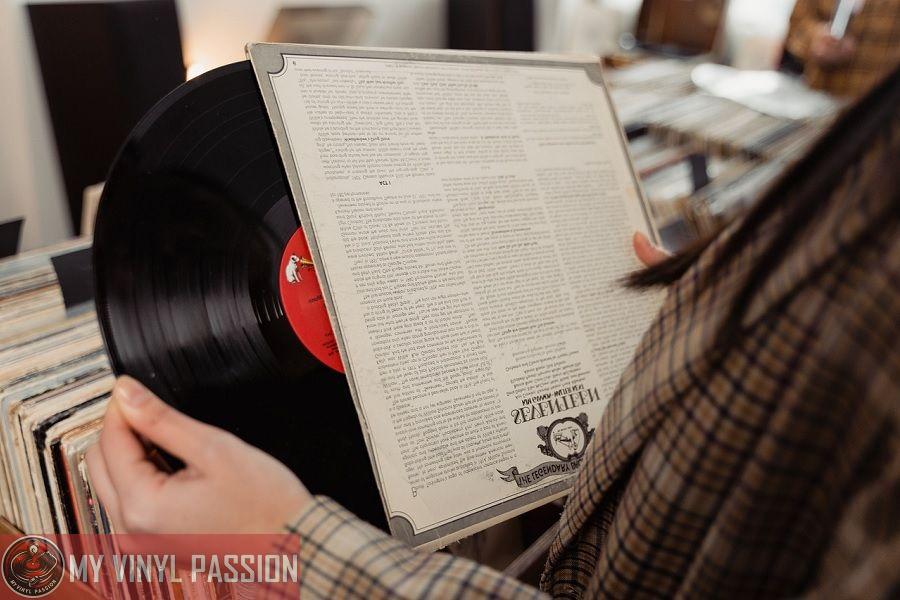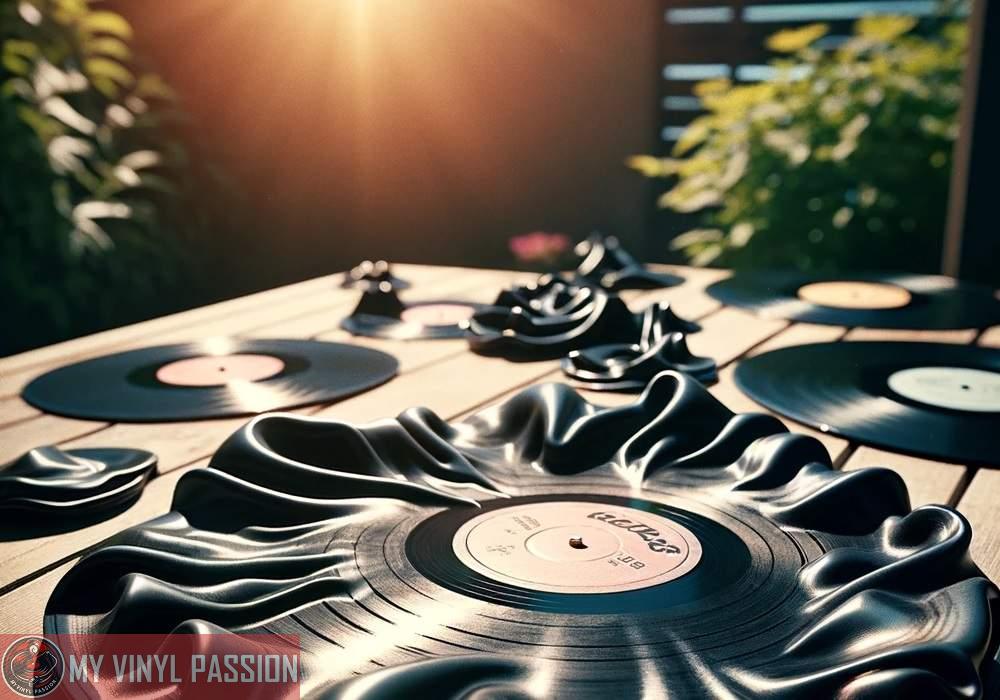Vinyl records have made a remarkable comeback, with their popularity surging among both audiophiles and casual listeners.
Their longevity is a testament to their physical durability, which continues to withstand the test of time and advances in music technology. Vinyl records can be quite durable and have a long lifespan if they are properly cared for and played on quality equipment.
But, they are not immune to wear and damage, especially if mishandled or exposed to unfavorable conditions.
In Summary
The lifespan of a vinyl record is influenced by environmental factors and handling; proper storage, cleanliness, and careful handling can significantly extend their life.
Vinyl records are primarily made from polyvinyl chloride (PVC), which is durable but prone to scratches and warping under poor storage conditions.
The condition of the playback equipment, particularly the turntable needle and weight, is crucial in determining the longevity of vinyl records.
The durability of vinyl records is also affected by their manufacturing process, including the materials used and the quality control during production, influencing their resilience and sound fidelity.
The lifespan of a vinyl record is influenced by various environmental and handling factors. If we store our records properly, keep them clean, and handle them with care, they can last for many decades without significant degradation in audio quality.
The composition of vinyl, essentially a plastic compound, allows it to preserve sound well, but it is also susceptible to scratches and warping which can diminish its fidelity.
Scratches can permanently alter the record’s grooves, which then affects playback quality. Warping, on the other hand, occurs due to poor storage conditions, like heat and pressure, which can distort the record’s flat surface.
We recognize that the player’s needle, the weight placed on the record, and the turntable’s conditions also play crucial roles in the life expectancy of a vinyl record.
Regular maintenance and proper handling are the keys to ensuring vinyl records remain not just functional collectibles but also quality mediums for experiencing music.
Material Composition of Vinyl Records
Vinyl records, commonly referred to as “records” or “LPs,” are crafted primarily from polyvinyl chloride (PVC). The durability of a record is often attributed to the resilience of this material. We observe that PVC provides a flexible yet sturdy base, which allows for the intricate grooves that store the audio information to be pressed into the surface.
To enhance the material properties, additional substances may be added during manufacturing:
- Stabilizers: These agents help in maintaining the integrity of the PVC under varying temperatures, reducing the risk of warping.
- Plasticizers: They are included to provide flexibility to the vinyl, aiding in the prevention of breakage.
- Fillers: These may be used to improve the vinyl’s strength and may affect the weight and quality of the playback.
The process of record pressing also involves a lacquer-coated aluminum disc, known as the stamper, which imprints the audio grooves onto the heated vinyl material.
Records come in a variety of weights and thicknesses, with some audiophiles asserting that heavier vinyl offers a more robust and potentially longer-lasting medium. Standard weights for records are:
- Standard: Usually around 120 grams
- Heavyweight: Ranging from 180 to 220 grams
The lifespan of a vinyl record is partly determined by its material composition. Our records’ proper care and handling can profoundly impact their longevity, keeping them playable for decades.
Manufacturing Process
The durability of vinyl records is greatly influenced by their manufacturing process, which includes precise stages such as mastering, molding, and strict quality control to ensure high fidelity and resilience.
Mastering and Lacquers
During mastering, the original audio recording is transferred onto a master disc, made of a lacquer-coated aluminum substrate. This master is then meticulously cut with a diamond stylus to imprint the audio grooves accurately, which serve as a blueprint for producing the final vinyl records.
Molding and Pressing
Molding and pressing involve creating the stamper from the master disc and then pressing it onto vinyl. High-quality polyvinyl chloride (PVC) is placed between the stampers in a hydraulic press. The result is a robust and durable vinyl record, with the capability to withstand numerous plays without significant degradation in sound quality.
Quality Control
Our commitment to durability extends to meticulous quality control. Each record undergoes visual and auditory checks to ensure it meets our high standards. Only vinyl records with clear playback and without defects pass this critical stage, thus affirming their durability and readying them for listeners’ enjoyment.
Properties Affecting Durability
The durability of vinyl records is influenced by several physical characteristics, including the vinyl thickness, record weight, and groove geometry. Understanding these properties can help us appreciate the resilience and longevity of vinyl as a format.
Vinyl Thickness
Thickness refers to the depth of the vinyl record, typically measured in millimeters. Thicker vinyl provides a more robust platform for the grooves, which can result in a more stable sound experience. On average, vinyl records have a thickness of about 1.2 millimeters. However, some audiophile pressings may opt for a 180-gram vinyl, which is thicker and deemed to be higher quality due to its increased mass and reduced susceptibility to warping.
Record Weight
The weight of a vinyl record is closely related to its thickness and can affect durability. Heavier weight records tend to be more durable because they are less likely to bend or warp over time. Standard records may weigh around 120 to 140 grams, while heavyweight records that offer enhanced durability can weigh in at 180 grams or more.
Groove Geometry
Groove geometry refers to the physical dimensions and shape of the grooves pressed into the vinyl surface. The width, depth, and precision of these grooves contribute to the record’s ability to reproduce sound accurately. It is essential because improper or worn-down grooves can degrade the sound quality quickly. Deeper and more defined grooves can potentially enhance a record’s durability, as they are less likely to wear down from the needle’s contact during playback.
By recognizing the impact of these properties, we gain insight into the resilience of vinyl records and how best to handle them for long-lasting use.
Handling and Maintenance
When it comes to vinyl records, durability is directly linked to how we store and clean them. Ensuring proper handling can extend the life and preserve the quality of our cherished collections.
Proper Storage
Vinyl records require upright storage in a cool, dry place to avoid warping and other kinds of damage. We recommend using shelves or crates specifically designed for vinyl storage that provide a snug fit to prevent records from leaning, which over time could lead to distortion. Avoid exposure to extreme temperatures and direct sunlight, as these can cause the vinyl to warp and the covers to fade.
Cleaning Techniques
Regular cleaning is vital to maintain the playback quality and longevity of vinyl records. We start with a soft, anti-static brush to remove surface dust before playing each record. For deeper cleaning, we prefer using a record-cleaning solution applied with a microfiber cloth or a record-cleaning machine. It’s important to dry the records completely before playing or storing to prevent mold growth. Remember to never touch the surface of the vinyl with our bare hands; the oils from our skin can attract dust and lead to static build-up.
Environmental Factors
In assessing the durability of vinyl records, we must closely consider environmental factors such as temperature, humidity, and sunlight. These elements can profoundly affect the lifespan of vinyl records, causing potential warping and degradation.
Temperature and Humidity
Excessive heat and humidity are particularly harmful to vinyl records. We recommend storing records at a consistent temperature to avoid warping. The ideal temperature for vinyl storage should be between 60 to 70 degrees Fahrenheit (15 to 21 degrees Celsius), and humidity levels should be kept around 45% to 50%.
Storing vinyl records in environments that deviate significantly from these conditions can lead to irreversible damage. The study on Independent record stores and the vinyl record revival highlights the importance of maintaining a stable environment to ensure the longevity of vinyl records.
Sunlight and UV Exposure
Vinyl records are also sensitive to sunlight and ultraviolet (UV) exposure. Prolonged exposure to direct sunlight can cause vinyl to fade, become brittle, and even warp. To preserve their quality, records should be stored away from direct sunlight in a place where they can remain cool and dry.
Protective sleeves or storage units that guard against UV rays are advantageous. In the book Decomposed: The political ecology of music, the effects of improper storage and exposure are discussed, reinforcing that careful handling and UV protection are essential in maintaining a vinyl record’s durability.
Playback and Equipment
In our exploration of vinyl record durability, we cannot overlook the role of playback equipment. The quality of the turntable and condition of the stylus are pivotal for maintaining the integrity of vinyl records.
Turntable Quality
A high-quality turntable is essential for minimizing vinyl wear. We prefer turntables with precise speed stability and adjustable tonearm settings to ensure even contact with the record’s surface. Factors like a well-damped platter and isolation from vibrations contribute to both better sound and reduced record wear.
Stylus Wear and Tear
The stylus, or needle, is a critical component that directly affects the lifespan of vinyl. A worn stylus can damage the delicate grooves of a record. We advise regular inspection and replacement of the stylus to preserve your vinyl’s grooves. It’s generally recommended to replace the stylus after every 1,000 hours of playtime to maintain the best playback quality and record longevity.
By investing in a robust playback system and diligently maintaining the stylus, we ensure that our vinyl collection can be enjoyed for many years.
Longevity Expectations
When we discuss the longevity of vinyl records, we refer specifically to the expected lifespan and factors that could shorten it.
Average Lifespan
Vinyl records have been known to last for decades if properly cared for; they can endure anywhere from 25 to upwards of 100 plays per side before experiencing a noticeable degradation in sound quality. Investments in quality turntables and sound systems can also play a part in extending the life of our vinyl records.
Factors Reducing Lifeson
Several key factors can significantly reduce the lifespan of our vinyl records. Environmental conditions such as extreme temperatures, sunlight, and humidity can warp or damage the records over time. Improper handling, like touching the surface with oily fingers, can introduce grime and scratches that degrade audio quality. Additionally, playing records on ill-maintained equipment with a worn needle can accelerate wear. Ensure to store vinyls in a cool, dry place and handle them by the edges to minimize these risks.
Common Issues and Restoration
In our extensive experience with vinyl records, we have identified that improper handling and environmental factors mainly contribute to their deterioration. Our focus here is to examine common problems such as scratches and warping, and to explore effective restoration methods.
Scratches and Warping
Vinyl records can suffer from scratches due to mishandling, which may lead to audio distortions or skipping during playback. Warping can also occur if vinyl is exposed to heat or inappropriate storage. These issues can degrade the listening quality and overall value of the records.
- Scratches: Can often be felt with a gentle finger touch and seen against a light source.
- Warping: Usually causes a noticeable change in the flatness of the vinyl when placed on a turntable.
Restoration Methods
Despite the delicate nature of vinyl, there are dedicated restoration methods to mitigate damage:
- Cleaning: Dust and small particles can be removed using special vinyl-safe solutions and soft microfiber cloths.
- Scratch Repair: Light scratches can be diminished through careful cleaning and, in some cases, with the use of professional-grade polish.
- Warp Correction: Warped records may be slowly flattened under controlled conditions using weights or clamps, but this requires precision to avoid further damage.
It is crucial to approach restoration with caution to prevent exacerbating the issues. For complex cases, it is advisable to consult a professional restorer, especially when dealing with rare or valuable items.
FAQs
What is the average lifespan of a vinyl record?
The average lifespan of a vinyl record, when properly cared for, can be several decades. Proper handling, storage, and use of good-quality playback equipment are key factors in extending its life.
Can vinyl records be easily scratched or damaged?
Yes, vinyl records can be susceptible to scratches and damage, especially if they are not handled properly. It’s important to handle them by the edges and avoid touching the grooves to minimize the risk of scratching.
How does the environment affect the durability of vinyl records?
Environmental factors like temperature, humidity, and sunlight can significantly impact the durability of vinyl records. They should be stored in a cool, dry place away from direct sunlight to prevent warping and deterioration.
Does the quality of the turntable affect the record’s durability?
Yes, the quality and condition of the turntable, particularly the stylus (needle), play a significant role in the longevity of a vinyl record. A worn or damaged stylus can cause excessive wear or scratching.
Is it possible to repair a damaged vinyl record?
Minor scratches might be mitigated with careful cleaning, but deep scratches and warping are usually not repairable. Proper care and handling are the best ways to prevent damage and ensure the longevity of vinyl records.





